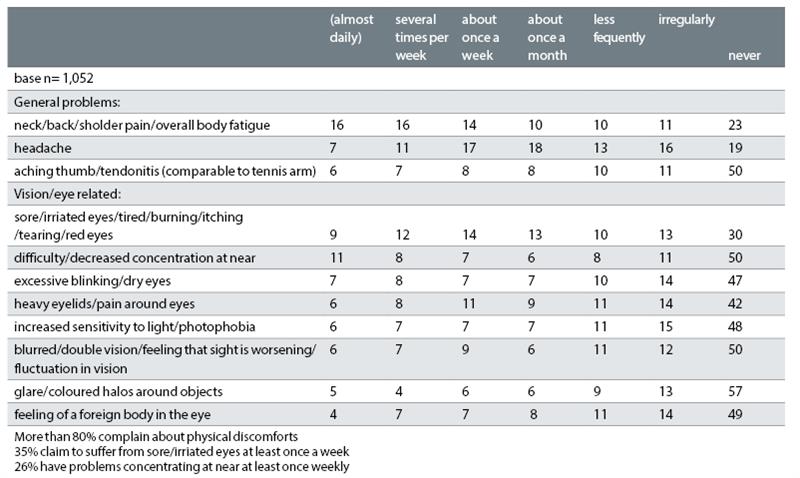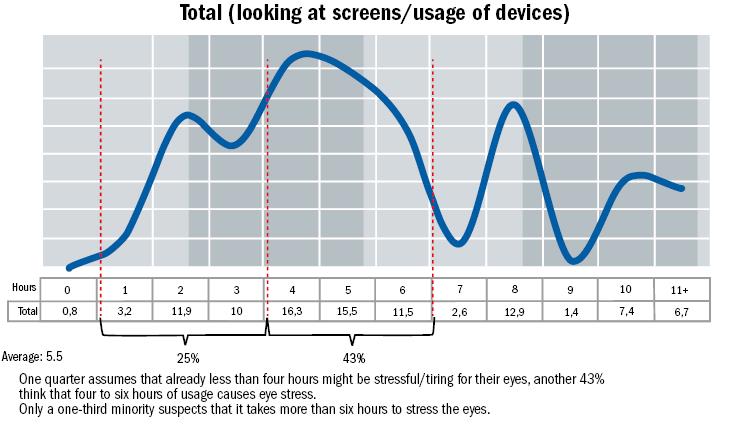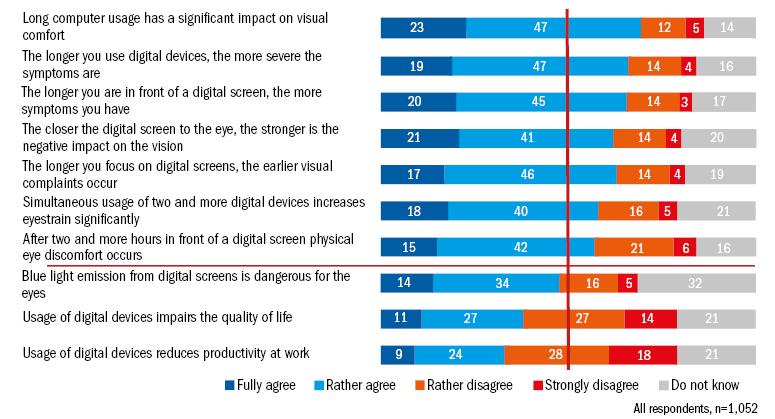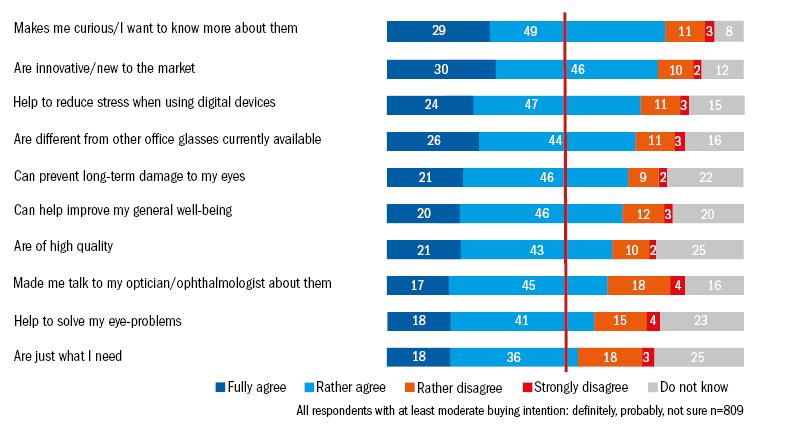Since the 1980s we have been using desktop PCs, in the nineties we added laptops, and for around the last 10 years most of us have not been able to imagine life without our tablet and smartphone.
On the one hand our digital devices make our lives easier, allowing unprecedented connection with the world around us. But on the other, our eyes are confronted with challenges that previous generations never had to face.
So how much do we use our digital devices, and does this use have an effect on our wellbeing? Are users aware of the impact digital screens can have on their eyes? What do they do to relieve eye strain? And how do patients react to the solution that companies like Hoya and eye care professionals (ECPs) can offer them?
These are the questions examined in an international consumer survey by Hoya, conducted in cooperation with Elke Dobisch Marktforschung in autumn 2017. The project was carried out in the USA, Hong Kong, and the UK. This article focuses on the UK results.
Project design
The project involved an online survey with 1,052 respondents in the USA, Hong Kong, and the UK. Participants were categorised by age (inclusion was restricted to those aged from 20 to 50 years old), gender and country location. The target group was defined as users of digital devices. People who worked in the optics industry or business, or who have any related conflicts of interests were excluded from the survey.
Structure of the sample in the UK was as follows:
- 49% men, 51% women
- average age: 35 years (men 36, women 35);
- 57% of the sample were users of prescription glasses and/or contact lenses (in the age-group 41-50, this reached 67%).
Results
Ninety percent of the UK respondents regularly use smartphones. Three quarters have laptops, and slightly more than half of the participants use iPads/tablets. In other words, parallel usage of more than one digital device is normal.
Only half of the UK respondents regularly use a desktop device. Mobile devices already outnumber stationary PCs by more than in any other region of the survey. And while desktop devices are mainly used for work-related tasks (albeit often for the full working day), mobile devices play an important role in leisure time.
Two-thirds of the respondents claim to use their smartphones, laptops, tablets etc for no more than four hours per day. But that’s for each device. As more than 90% have two or more devices, and there is constant and often parallel use of them, we can see there is no such thing as ‘light-use’ of digital devices.
Usage of digital devices leads to physical discomfort
Many respondents are clearly aware of the potential issues, with one-third claiming to suffer from physical problems related to using digital devices. Those who require eyewear are significantly more affected: 40% of eyewear users claim to have problems that they relate to digital devices, compared to only 25% of non-users.

Regardless of whether they associate it with digital device use or not, more than 80% of those surveyed generally complain about physical discomfort. Women and younger respondents seem to be slightly more aware of these feelings compared to men and anybody over forty.
Most respondents claim to suffer frequent discomfort (at least once a week) from neck, back or shoulder pain, headaches, and sore, irritated eyes. About a quarter have difficulty concentrating, and nearly 10% state they have this problem (almost) daily. Most of the problems occur during working hours, after work and at night. The physical symptoms and their frequency are outlined in figure 1.

Figure 1: Frequency of physical discomforts (% of respondents): ‘How often do you suffer from...?’
Generally, 99% of those asked believe the use of digital devices has a negative impact upon the eyes as summarised in figure 2.
The statement summary (figure 3) confirms that the respondents see a strong correlation between the duration of use and the negative impact on the eyes, although they do not generally question the usage of digital devices (last two statements).

Figure 2: Assumptions regarding negative influence of using digital devices: ‘How many hours of looking at digital screens/usage of digital devices might be stressful/tiring for your eyes?’ (open)
Patients suffer in silence
When feeling uncomfortable after prolonged use of computers and digital devices, the preferred solution of most respondents is simple: take a screen break. General problems such as physical pain are dealt with by stretching and moving, and even by using painkillers.

Figure 3: Impact of using digital devices/looking at screens:
‘To what extent do you agree with the following statements?’
Vision or eye-related irritations are relieved by rubbing one’s eyes or by changing the viewing conditions, such as altering lighting or spectacle use. Only a few of the respondents use artificial teardrops to combat dry eye symptoms.
More than 10% of those surveyed claim to have tried multiple solutions to resolve their symptoms without success. Surprisingly, more than half of those affected by eye problems never talked to anyone about this issue, and less than 20% have been to see an eye care professional about it.
Those who did visit an ECP were initially recommended new or different glasses or contact lenses. So, it’s not surprising that the terms digital eye syndrome (DES) and computer vision syndrome (CVS) are known to less than 20% of the participants – and among those who do not use corrective eyewear, the awareness is less than 15%.
Solutions are most welcome
After discussing their digital usage habits and levels of physical discomfort in the first part of the questionnaire, the respondents were presented with an offer of new Hoya lenses SYNC III designed to reduce digital eye strain.
More than 50% of the respondents showed a spontaneous interest in this offer. Three quarters said they would consider them, and a good third claimed they would consider buying them within the next two years. Figure 4 summarises the attitudes from participants to a potential spectacle lens remedial option.

Figure 4: Perception of the lenses: ‘To what extent do you agree with the following statements that other respondents made about this offer?’
The majority of respondents perceive the lenses to be new and innovative, with curiosity created among both eyewear users and non-users. Around three quarters of the respondents believe the lenses will help to reduce stress when using digital devices, and will also prevent long-term damage to the eyes – a belief that even non-users of eyewear support.

More than 50% of all respondents agree that they would like to talk to an eye care professional about these lenses. In fact the biggest trigger to consideration is recommendation by the ECP as 71% of the spectacle users trust the recommendations of their ECP (also checked in the questionnaire).
The survey also showed that different target groups respond to different messages. If the target group description is: ‘designed for people between the ages of 13 and 45’, it especially attracts younger respondents. If it is pointed out that the product is useful even for non-users of eyewear, it achieves higher acceptance among wearers of contact lenses, ready readers, and those who do not (yet) use any corrective eyewear. This said, respondents do fear a high price for the product.
Conclusion
Users of digital devices in the UK are aware that constant use of digital screens has a negative influence on their wellbeing. Once they understand that there is a solution to reduce their eye stress, they’re open to it. Even non-users of eyewear can be attracted to glasses that bring relief, as long as the specification meets their needs.
Elke Dobisch is a researcher based at Elke Dobisch Marktforschung, Munich, Germany.
Dr Natalia Vlasak is Clinical Research Specialist at Global Marketing, Hoya Vision Care, The Netherlands.
Andrew Sanders is Professional Services Manager, Hoya Lens UK and Ireland
